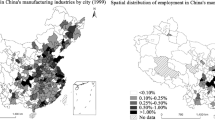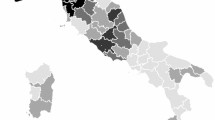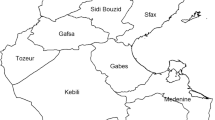Abstract
Location theorists have emphasized the importance of agglomeration economies in explaining the concentration of industrial activity. They have divided these economies into portions that relate to average industry size, firm size, and market size. This study examines these three factors, in the context of value created, and concludes that each is statistically different for high tech industries in comparison to non-high tech industries. This finding adds an important dimension to state industrial development strategies, particularly those focused on high tech.
Similar content being viewed by others
References
Acs, Zoltan J. and David B. Audretsch, 1987, ‘Innovation, Market Structure and Firm Size’,Review of Economics and Statistics 69(4), 567–575.
Acs, Z. J. and David B. Audretsch, 1988, ‘Innovation in Large and Small Firms: An Empirical Analysis’,American Economic Review 78(4), 678–690.
Acs, Zoltan, David B. Audretsch, and Maryann P. Feldman, 1992, ‘Real Effects of Academic Research’,American Economic Review 82, 363–367.
Acs, Zoltan, David B. Audretsch, and Maryann P. Feldman, 1993, ‘R&D Spillovers and Recipient Firms Size’,Review of Economic and Statistics 75(4).
Begg, I. G. and G. C. Cameron, 1988, ‘High Technology Location and the Urban Areas of Great Britain’,Urban Studies 25, 361–379.
Bezdek, Roger H., 1975, ‘The 1980 Economic Impact Regional and Occupational — of Compensated Shifts in Defense Spending’,Journal of Regional Science 15(2), 183–98.
Bernstein, J. I. and Ishaq Nadiri, 1988, ‘Interindustry R&D Spillover, Rates of Return and Production in High-Tech Industries’,American Economic Review 78(2), 429–434.
Browne, L. E., 1984, ‘High Technology and Regional Economic Development’,Economic Indicators, Federal Reserve Bank of Boston.
Carlino, G. A., 1980, ‘Contrasts in Agglomeration: New York and Pittsburgh Reconsidered’,Urban Studies 17, 3433–3451.
Caves, Richard E. and Thomas Pugel, A., 1980,Intra-Industry Differences in Conduct and Performance: Viable Strategies in U.S. Manufacturing Industries, New York, New York: New York University Press.
Chinitz, B., 1961, ‘Contrasts in Agglomeration: New York and Pittsburgh’,American Economic Review 50, 279–89.
Edwards, Keith L. and Theodore, J. Gordon, 1984, ‘Characterization of Innovations, Introduced on the U.S. Market in 1982’,The Futures Groups, U.S. Small Business Administration, Contract No. SBA-6050-0a-82.
Employment and Earnings. U.S. Bureau of Labor Statistics, 1990 and 1975.
Evans, A. W., 1986, ‘Comparisons of Agglomeration: Or What Chinitz Really Said’,Urban Studies 23, 387–389.
Galbraith, C., 1985, ‘High Technology Location and Development: The Case of Orange County’,California Management Review 28(1), 98–109.
Grilliches, Zvi, 1979, ‘Issues in Assessing the Contribution of R&D to Productivity Growth’,Bell Journal of Economics 10, 92–116.
Hill, A. and C. Naroff, 1984, ‘The Effect of Location on the Performance of High Tech Firms’,Financial Management 13, 27–36.
Jaffe, Adam B., 1986, ‘Technological Opportunity and Spill-overs of R&D: Evidence from Firms' Patents Profits and Market Value’,American Economic Review 76, 984–1001.
Jaffe, Adam B., 1989, ‘Real Effects of Academic Research’,American Economic Review 79(5), 957–970.
Lund, Leonard, 1986, ‘Locating Corporate R&D Facilities’, Conference Board Report No. 892, Conference Board, New York.
Mansfield, Edwin, 1981, ‘Composition of R and D Expenditures: Relationship to Size of Firm Concentration and Innovative Output’,Review of Economics and Statistics 63, 610–615.
Mansfield, Edwin, 1984, ‘Comment on Using Linked Patent and R&D Data to Measure Interindustry Technology Flows’, in Zvi Grilliches (ed.),R&D, Patents and Productivity, Chicago: University of Chicago.
Markusen, A., P. Hall, and A. Glasmeier, 1986,High Tech America, Boston: Allen & Unwin.
Miller, J. P., 1989, ‘The Product Cycle and High Technology Industry in Non-Metropolitan Areas, 1976–1980’,The Review of Regional Studies 19(1), 1–12.
Riche, R., D. E. Hecker, and J. U. Burgan, 1983, ‘High Technology Today and Tomorrow: A Small Slice of the Employment Pie’,Monthly Labor Review, 50–58.
Saxenian, A. ‘The Genesis of Silicon Valley’, in P. Hall and A. Markusen (eds.),Silicon Landscapes, Boston, MA: Allen & Unwin.
Scott, A. J. and Storper, M., 1987, ‘High Technology Industry and Regional Development: A Theoretical Critique and Reconstruction’,International Social Science Journal 112, 216–232.
Smith, T. R. and M. Borowski, 1985, ‘High-Technology Development in the Tenth District’,Economic Review 924.
Vozikis, G. S. and E. Gross, 1987, ‘High Tech Venture Initiation in High Tech vs Low Tech Regions’, A presentation at the 1987 Annual Meeting of the Academy of Management, New Orleans, LA.
Winter, Sidney G., 1984, ‘Schumpeterian Competition in Alternative Technological Regimes’,Journal of Economic Behavior and Organization 5, 287–320.
Author information
Authors and Affiliations
Rights and permissions
About this article
Cite this article
Goss, E., Vozikis, G.S. High tech manufacturing: Firm size, industry and population density. Small Bus Econ 6, 291–297 (1994). https://doi.org/10.1007/BF01108396
Accepted:
Issue Date:
DOI: https://doi.org/10.1007/BF01108396




